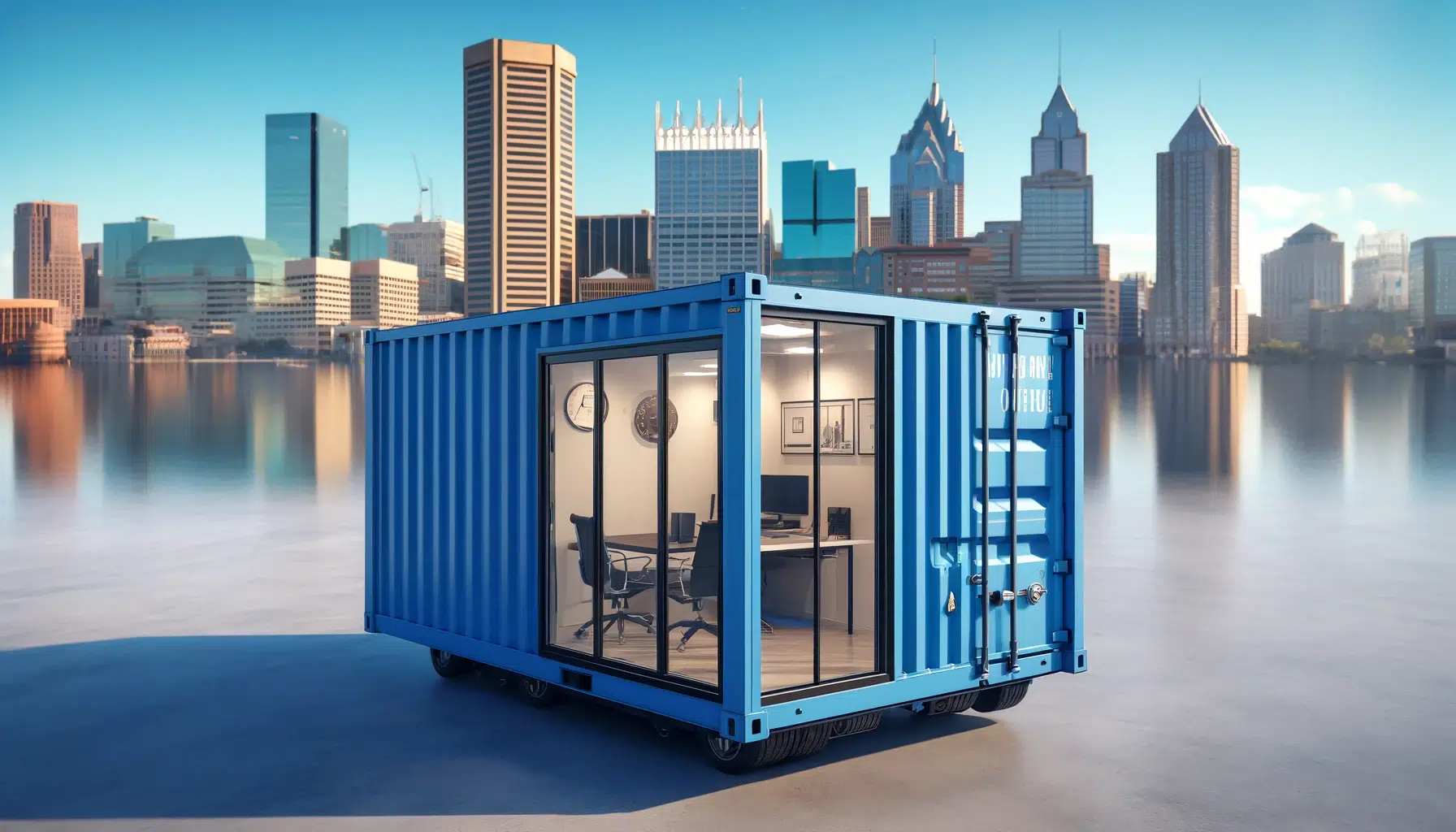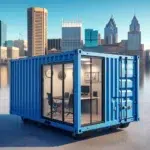Lately there’s been a growing trend of building shipping container gyms. These unique workout spaces offer durability, cost-effectiveness, and versatility for fitness enthusiasts looking to create their own personal gym.
The appeal of a shipping container home gym lies in its ability to provide a functional and innovative workout environment that can be customized to suit individual needs and preferences. Want to learn how to make your own? Let’s look at what you need to know.
3 Benefits of Using a Shipping Container for a Gym
Buying a shipping container to use it as the foundation for a gym brings several advantages, including these three:
- Shipping containers are durable, weather-resistant, and built to withstand harsh conditions, making them ideal for long-lasting gym structures. Unlike traditional gym buildings, which may require frequent repairs and renovations, shipping container gyms offer a sturdy and reliable option. They are designed to withstand extreme weather conditions, ensuring that the gym remains intact and functional for years to come.
- Converting a shipping container into a gym allows for cost-effectiveness, as it eliminates the need for expensive gym memberships and commuting expenses. Traditional gyms often require monthly membership fees, which can quickly add up over time. Additionally, commuting to and from the gym can be time-consuming and costly, especially for individuals who live in urban areas with heavy traffic. By building a shipping container gym, fitness enthusiasts can save money on monthly fees and commuting expenses, making it a more affordable option in the long run.
- The versatility of shipping containers enables creative design options, resulting in a unique and functional workout space. Shipping containers can be customized to suit individual preferences and needs. Whether it’s adding windows for natural light, installing exterior paneling for aesthetic appeal, or incorporating artwork to create an inspiring environment, the possibilities are endless. This level of customization allows fitness enthusiasts to create a gym that reflects their personal style and motivates them to achieve their fitness goals.
A shipping container gym in New York City was designed with a transparent roof to allow natural light to flood the space. This not only creates a bright and inviting atmosphere but also reduces the need for artificial lighting during the day, resulting in energy savings. Additionally, the gym features a living wall covered in plants, which not only adds a touch of greenery but also improves air quality and creates a calming environment for workouts.
4 Steps for Converting a Shipping Container into a Gym
Converting a shipping container into a gym requires careful planning and execution. Here are the four major steps to follow:
- Select a suitable container: Consider factors such as size, condition, and special features when choosing a container for your gym. Ensure that the container is in good structural condition and free from any potential hazards. Inspect the container for any signs of corrosion or damage that may compromise its integrity.
- Plan the layout and design: Maximize the limited space by planning the layout strategically. Consider safety measures and incorporate necessary equipment while ensuring sufficient space for movement. Evaluate the dimensions of the container and create a floor plan that optimizes the available space. Consider the placement of equipment, storage areas, and any additional features such as windows or ventilation systems.
- Insulate and seal the container: Proper insulation is crucial for temperature control and preventing issues with water and humidity. Insulating the container will help create a comfortable workout environment and protect equipment from moisture damage. Choose insulation materials that are suitable for the local climate and ensure that the insulation is properly installed to maximize its effectiveness.
- Install necessary utilities: Depending on the location of the container gym, you may need to install utilities such as electricity, plumbing, and HVAC systems. Consult with professionals to ensure that these utilities are installed safely and meet all necessary codes and regulations.
To illustrate the process of converting a shipping container into a gym, let’s consider an example. Sarah, a fitness enthusiast, decides to build her own shipping container gym in her backyard. She does her research and finds a suitable container that is in good condition and free from any potential hazards.
Sarah plans the layout of her gym by considering safety measures and incorporating necessary equipment. She insulates the container using foam insulation to regulate temperature and prevent condensation.
She installs vents to ensure adequate ventilation and chooses rubber flooring for its durability and shock-absorbing properties. After completing the necessary modifications, Sarah has her own personalized shipping container gym, tailored to her fitness needs and preferences.
Sarah decides to take her customization to the next level by adding large windows to her gym. The windows not only provide natural light but also offer a view of her beautifully landscaped backyard, creating a serene and inspiring atmosphere for her workouts. She also chooses to include a small outdoor patio area adjacent to the gym, where she can enjoy fresh air and outdoor exercises.
Cost Comparison: Shipping Container Home Gym vs Traditional Gym
Building a shipping container gym can provide long-term cost savings compared to a traditional gym. While the initial costs of purchasing a shipping container and outfitting it with equipment may seem significant, the overall expenses can be lower in the long run.
Here’s a breakdown of the four main costs to consider:
- The container itself: The cost of purchasing a shipping container varies depending on factors such as size, condition, and location. Used containers are generally more affordable than new ones. It’s important to assess the condition of the container thoroughly to ensure it is structurally sound and free from any potential hazards.
- Equipment: The cost of gym equipment can vary greatly depending on the type and brand. It’s important to prioritize essential equipment based on your fitness goals and budget. Consider purchasing second-hand equipment or searching for deals to save money.
- Modifications and installations: Insulation, ventilation systems, flooring, and utilities may require additional expenses. These costs will depend on the specific requirements of your shipping container gym and the local prices for labor and materials.
- Maintenance and operating costs: Shipping container gyms generally have lower maintenance costs compared to traditional gyms. Regular inspections and maintenance should be conducted to ensure the gym remains in good condition. Operating costs such as electricity and water usage should also be factored into the overall expenses.
As an example, John is considering building a shipping container gym in his backyard, while his friend David is planning to join a traditional gym. John estimates that purchasing a used shipping container and outfitting it with equipment and necessary modifications will cost him around $10,000.
On the other hand, David calculates that an annual gym membership, including commuting expenses, will amount to approximately $1,500. Over a period of five years, John’s total expenses for his shipping container gym would be $10,000, while David’s total expenses for the traditional gym would be $7,500. In this scenario, John’s shipping container gym proves to be a more cost-effective option in the long run.
Personalization and Customization Options
One of the advantages of building a shipping container gym is the ability to personalize and customize the space according to individual preferences and fitness goals. Here are four options to consider:
- Exterior paneling: Personalize the exterior of your container by adding paneling or cladding materials. This can enhance the aesthetic appeal of the gym and make it visually appealing from the outside. Choose materials that are weather-resistant and durable to withstand outdoor conditions.
- Flooring: The choice of flooring can greatly impact the overall look and functionality of your gym. Consider options such as rubber flooring, vinyl, or hardwood. Each material offers different benefits in terms of durability, maintenance, and comfort. Select a flooring option that suits your workout routines and preferences.
- Windows and lighting: Adding windows to your shipping container gym not only provides natural light but also enhances the overall ambiance. Consider the placement and size of the windows to maximize the view and allow for proper ventilation. Additionally, choose appropriate lighting fixtures to ensure sufficient illumination during workouts.
- Artwork and decor: Personalize the interior of your gym by adding artwork, motivational quotes, or graphics that inspire and energize. This can create a unique and motivating atmosphere for workouts. Consider incorporating colors and designs that resonate with your fitness journey.
A shipping container gym in Toronto features exterior paneling made from reclaimed wood, giving it a rustic and eco-friendly look. The gym also has a sprung wood floor, which provides excellent shock absorption and a comfortable surface for various exercises.
Large windows are strategically placed to maximize natural light and offer views of a nearby park, creating a refreshing and inspiring workout environment. Inside the gym, motivational quotes and vibrant artwork adorn the walls, adding a personal touch and reinforcing positive energy during workouts.
Insulation, Ventilation, and Flooring Considerations
Proper insulation, ventilation, and flooring are essential considerations when building a shipping container gym. These elements contribute to creating a comfortable and functional workout environment:
- Insulation is crucial for temperature control within the gym and protecting equipment from moisture damage. When insulating a shipping container gym, it’s important to choose insulation materials that are suitable for the local climate. In colder climates, insulation with a higher R-value may be necessary to keep the gym warm during winter months. On the other hand, in hotter climates, insulation that provides thermal resistance to heat transfer can help maintain a comfortable temperature inside the gym.
- Ventilation is necessary for maintaining healthy air quality and regulating temperature within the gym. Proper ventilation helps remove stale air and reduce the buildup of moisture and odors. This is particularly important in a confined space like a shipping container gym. Installing vents or fans can help circulate fresh air and prevent the gym from becoming stuffy or humid.
- Choose a flooring option that can withstand the demands of a gym environment. Rubber flooring is a popular choice for shipping container gyms due to its durability and shock-absorbing properties. It provides a cushioned surface that reduces the impact on joints and equipment, making it ideal for activities such as weightlifting and cardio exercises. Rubber flooring also offers excellent traction, reducing the risk of slips and falls during workouts.
3 Must-Haves for Ensuring Durability and Longevity
To ensure the durability and longevity of a shipping container gym, proper maintenance and high-quality materials are essential. Here are three steps to follow:
- Regular inspections: Regularly inspect your container home gym for any potential issues or damage. Check for signs of corrosion, leaks, or structural problems. Address any issues promptly to prevent further damage and ensure the gym remains safe and functional.
- Use high-quality materials: When converting a shipping container into a gym, it’s important to use high-quality materials that are suitable for the intended purpose. This includes insulation, flooring, and any additional installations. Investing in quality materials will contribute to the longevity of the gym and reduce the need for frequent repairs or replacements.
- Follow maintenance practices: Establish a maintenance routine for your gym. This may include regular cleaning, lubrication of equipment, and inspections of insulation and ventilation systems. Following proper maintenance practices will help extend the lifespan of the gym and ensure it remains in optimal condition.
Wrapping Up
Building a shipping container gym offers numerous benefits, including durability, cost-effectiveness, versatility, and personalization. By utilizing shipping containers as the foundation for a gym, you can create unique and functional workout spaces that cater to their individual needs and preferences.
Why not consider building your own shipping container gym today? Contact our team for a quote and we’ll get back to you within a few business days.









